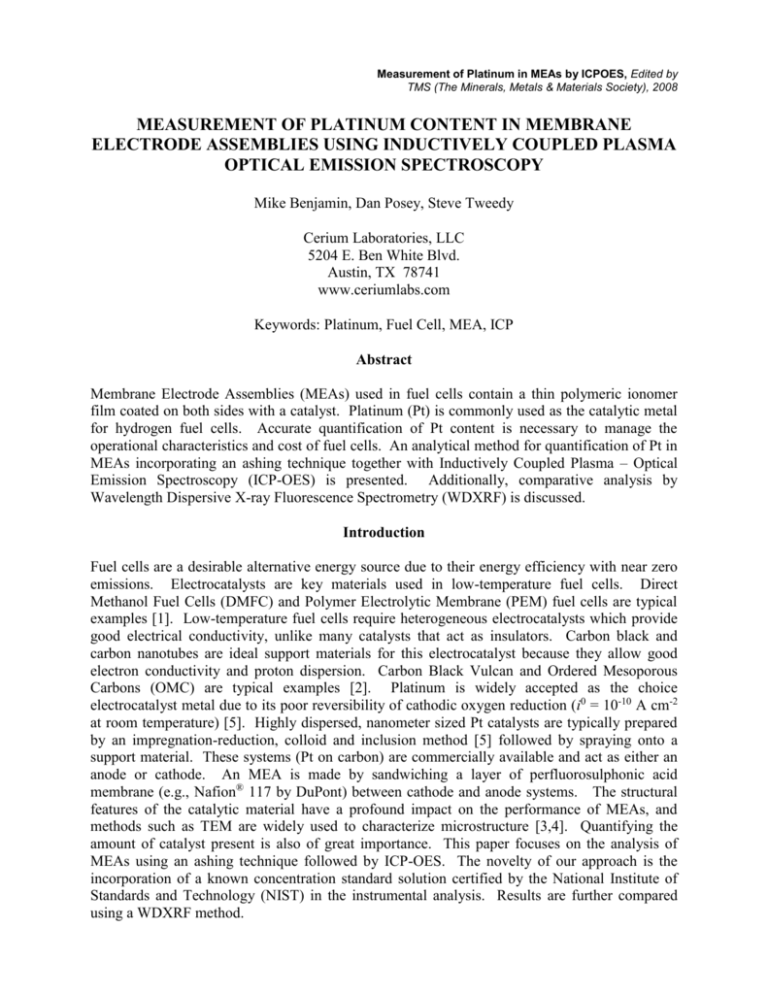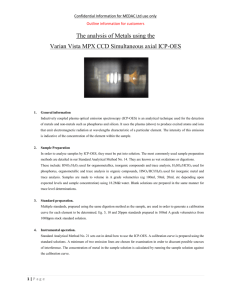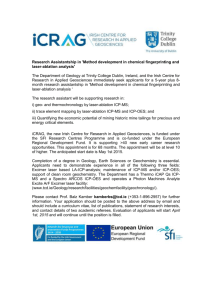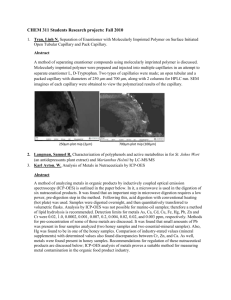Measurement of Platinum Content in Membrane
advertisement

Measurement of Platinum in MEAs by ICPOES, Edited by TMS (The Minerals, Metals & Materials Society), 2008 MEASUREMENT OF PLATINUM CONTENT IN MEMBRANE ELECTRODE ASSEMBLIES USING INDUCTIVELY COUPLED PLASMA OPTICAL EMISSION SPECTROSCOPY Mike Benjamin, Dan Posey, Steve Tweedy Cerium Laboratories, LLC 5204 E. Ben White Blvd. Austin, TX 78741 www.ceriumlabs.com Keywords: Platinum, Fuel Cell, MEA, ICP Abstract Membrane Electrode Assemblies (MEAs) used in fuel cells contain a thin polymeric ionomer film coated on both sides with a catalyst. Platinum (Pt) is commonly used as the catalytic metal for hydrogen fuel cells. Accurate quantification of Pt content is necessary to manage the operational characteristics and cost of fuel cells. An analytical method for quantification of Pt in MEAs incorporating an ashing technique together with Inductively Coupled Plasma – Optical Emission Spectroscopy (ICP-OES) is presented. Additionally, comparative analysis by Wavelength Dispersive X-ray Fluorescence Spectrometry (WDXRF) is discussed. Introduction Fuel cells are a desirable alternative energy source due to their energy efficiency with near zero emissions. Electrocatalysts are key materials used in low-temperature fuel cells. Direct Methanol Fuel Cells (DMFC) and Polymer Electrolytic Membrane (PEM) fuel cells are typical examples [1]. Low-temperature fuel cells require heterogeneous electrocatalysts which provide good electrical conductivity, unlike many catalysts that act as insulators. Carbon black and carbon nanotubes are ideal support materials for this electrocatalyst because they allow good electron conductivity and proton dispersion. Carbon Black Vulcan and Ordered Mesoporous Carbons (OMC) are typical examples [2]. Platinum is widely accepted as the choice electrocatalyst metal due to its poor reversibility of cathodic oxygen reduction (i0 = 10-10 A cm-2 at room temperature) [5]. Highly dispersed, nanometer sized Pt catalysts are typically prepared by an impregnation-reduction, colloid and inclusion method [5] followed by spraying onto a support material. These systems (Pt on carbon) are commercially available and act as either an anode or cathode. An MEA is made by sandwiching a layer of perfluorosulphonic acid membrane (e.g., Nafion® 117 by DuPont) between cathode and anode systems. The structural features of the catalytic material have a profound impact on the performance of MEAs, and methods such as TEM are widely used to characterize microstructure [3,4]. Quantifying the amount of catalyst present is also of great importance. This paper focuses on the analysis of MEAs using an ashing technique followed by ICP-OES. The novelty of our approach is the incorporation of a known concentration standard solution certified by the National Institute of Standards and Technology (NIST) in the instrumental analysis. Results are further compared using a WDXRF method. Experimental Membrane electrode assemblies were obtained from a commercial provider. The assemblies were ordered with specifications of 10cm by 10cm with a Nafion® 117 ionomer layer. Platinum on carbon loading was 0.3mg/cm2 per cathode/anode. A paper hole-punch was used to subsample the membranes. Surface area of one side of a singular punch-out was determined by a mass ratio. Four, 30ml porcelain crucibles were pre-cleaned using hot aqua regia (3:1 HCl:HNO3) and rinsed with ultra-pure water (UPW). One, two and three punch-outs were placed into three separate 30ml porcelain crucibles. The fourth crucible was left empty to serve as a reagent blank. Crucibles were placed in a muffle furnace at 800°C for one hour to ensure thorough ashing. Typical Pt on carbon ashing occurs at 500°C, but certain types of nonpolymeric gas diffusion layers (GDLs) require more heat. After cooling the crucibles to room temperature, ash residues were dissolved in 4ml of hot aqua regia, quantitatively transferred to 50ml conical sample tubes and diluted to 50ml with UPW. Measurement of Pt by ICP-OES was performed using a Varian Liberty II Series instrument with an HF-resistant torch in the radial position and a v-groove type nebulizer. Power settings for the ICP were 1200W with photomultiplier tube detector settings at 665V. An external calibration for Pt was performed at three separate wavelengths (214.423nm, 265.945nm, and 306.471nm) using an NIST traceable Pt single element standard solution. The calibration was performed over the range of 5 to 20ppm. A 266nm spectrum for Pt is shown (Figure 1). A calibration curve for the measurement of Pt at 266nm over the range of 5 to 20ppm is shown in Figure 2. Sample measurements included reagent blanks and check standards at both the beginning and end of each sequence. When necessary, samples were diluted to fit in the calibration range. Figure 1. 5ppm Pt spectrum at 266nm Figure 2. Pt calibration curve 5 to 20ppm at 266nm (R2 = 0.9995) Correlation to ICP-OES results was performed using WDXRF spectroscopy. A calibration was performed using a 1000ppm NIST traceable Pt standard solution. Measured volumes of this solution were deposited onto paper smear tabs, dried and measured. Platinum from zero to 350ug is shown to exhibit a second order calibration curve (Figure 3). Pt by WDXRF 25 Intensity (kcps) 20 15 2 y = -0.0001x + 0.0986x 2 R = 0.9973 10 5 0 0 50 100 150 200 250 Pt (ug) NIST solution std. Figure 3. WDXRF Calibration Curve for Pt 300 350 400 For the MEA sample, a punch-out was obtained in the same manner as for ICP-OES and measured with a Shimadzu XRF1500. The primary x-ray source was an unfiltered rhodium target operated at 40kV and 70mA. The sample aperture was 30mm diameter. Platinum Lα xrays were measured using a LiF analyzing crystal in a vacuum spectrometer operated at approximately 30Pa pressure. Measurement was made at a 2θ angle of 38.04 degrees using a scintillation detector. Results For the ICP-OES analysis, the concentration values obtained from each of the three wavelengths were averaged to give a single ppm value per sample. Final sample concentration values were calculated using Equation 1 with symbols defined by Table 1. Equation 1. Cf = (Ci – RBL) * V / SA / n / 2 Symbol Definition Units Ci RBL V Concentration (obtained from average of 3 measure lines) Reagent Blank Concentration Volume ppm ppm L SA n Surface area of one side of a punch-out Number of punch-outs cm2 none Cf Concentration final mg/cm2 Table 1. Symbol definitions for calculating final concentration values (ICP-OES). Results for analysis of the 0.3mg/cm2 MEA are tabulated in Table 2. Percent Relative Standard Deviation (%RSD) is shown in Table 3. Ci RBL V SA 3.8825 -0.0018 0.0500 0.3189 7.5850 -0.0018 0.0500 0.3189 11.4435 -0.0018 0.0500 0.3189 Table 2. Results of ICP-OES Analysis. n 1 2 3 Cf 0.3045 0.2973 0.2990 Xbar S %RSD 0.3003 0.0037 1.239 Table 3. %RSD using ICP-OES Analysis for 3 samples. For WDXRF comparative analysis, intensities from sample measurements were referenced to the calibration curve (Figure 3) to yield a mass result (MPt) and final concentration was calculated using Equation 2. Results are tabulated (Table 4). Equation 2. Cf = MPt / SA / 1000 / 2 MPt Cf SA 177.899 0.3189 0.2789 Table 4. Results of WDXRF Analysis. Results from both analyses are shown side-by-side (Table 5). Cf (ICP-OES) Cf (WDXRF) 0.3003 0.2789 Table 5. ICP-OES and WDXRF results. Target specified concentration value (C0) for MEA (0.3mg/cm2) is compared to concentration results obtained from ICP-OES technique and percent difference between measured ICP-OES results and expected specified results calculated (Table 6). Cf (ICP-OES) C0 % Difference 0.3003 0.3000 0.0964 Table 6. Percent difference between measured and specified results by ICP-OES. Conclusion Although the ICP-OES method is destructive to the sample and requires more time to allow for ashing, results are reproducible and highly accurate due to the use of NIST traceable standards used for instrument calibration. This is highlighted by obtaining less than one percent difference in measured vs. expected values for the MEA sample. Furthermore, Pt detection limits are low at 25ug. The WDXRF comparative analysis shows similar results, but is less accurate due to matrix differences between calibration standards and samples. Several fuel cell variations can be analyzed by this ICP-OES method. A cathode system can be analyzed in the same manner as an anode system or a full MEA with GDL layer. To date, polymeric and fabric GDLs (Pt loaded) and uncoated Nafion® membranes have been successfully analyzed with this ashing procedure. The method is appropriate for other metals as well; we have measured 33 elements with good recoveries. As fuel cells have evolved, binary systems using two electrocatalysts have emerged (e.g., Pt/Co). Typically, one metal is at high concentration and the other at low concentration. We have successfully used this same technique followed by High Resolution ICP-MS (HR-ICPMS) instead of ICP-OES (for sensitivity improvements) to accurately measure the low concentration element. References 1. Shijun Liao, Baitao Li, and Yingwei Li, PEM Fuel Cell Electrocatalysts and Catalyst layers (Springer London, 2008), 487. 2. E.P. Ambrosio et al., “Mesoporous Carbons as Low Temperature Fuel Cell Platinum Catalyst Supports,” Journal of Applied Electrochemistry, 2008, no. 38:1019-1027. 3. N. Martz, C. Roth, and H. Fuess, “Characterization of Different Pt/Metal/Complex Catalysts as Anode Catalysts for the PEM Fuel Cell,” Journal of Applied Electrochemistry, 2005, no. 35:85-90. 4. C. Roth, N. Martz, and H. Fuess, “An X-ray Diffraction and Transmission Electron Microscopy Study of Pt-Ru Fuel Cell Catalysts Before and After Operation,” Journal of Applied Electrochemistry, 2004, no. 34:345-348. 5. J.H. Tian et al., “Effect of Preparation Conditions of Pt/C Catalysts on Oxygen Electrode Performance in Proton Exchange Membrane Fuel Cells,” Journal of Applied Electrochemistry, 2004, no. 34:460-467.










